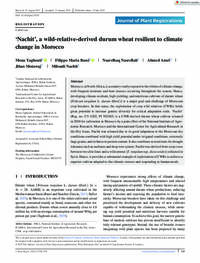‘Nachit’, a wild-relative-derived durum wheat resilient to climate change in Morocco

Authors:
Morocco, in North Africa, is a country vastly exposed to the whims of climate change,with frequent moisture and heat stresses occurring throughout the season. Hence,developing climate-resilient, high-yielding, and nutritious cultivars of durum wheat[Triticum turgidumL.durum(Desf.)] is a major goal and challenge of Moroccancrop breeders. In that sense, the exploitation of crop wild relatives (CWRs) holdsgreat potential to increase genetic diversity for critical adaptation traits. ‘Nachit’(Reg. no. CV-1202, PI 702365) is a CWR-derived durum wheat cultivar releasedin 2018 for cultivation in Morocco by a joint effort of the National Institute of Agro-nomic Research, Morocco and the International Center for Agricultural Research inthe Dry Areas. Nachit was released due to its good adaptation to the Moroccan dryconditions combined with high yield potential under irrigated conditions, extremelylarge grains, and richness in protein content. It also combines several traits for droughttolerance such as earliness and deep root system. Nachit was derived from a top crossbetween two elite lines and a wild emmer [T. turgidumssp.dicoccoides] collected inSyria. Hence, it provides a substantial example of exploitation of CWRs to achieve asuperior cultivar adapted to the climatic stresses and responding to human needs.
